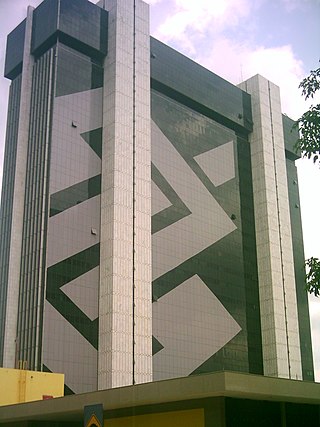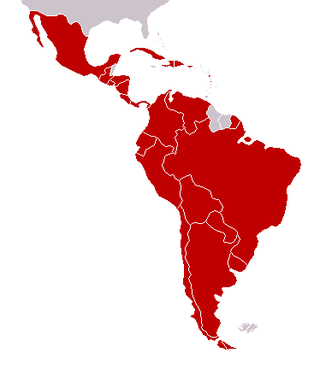
The economy of Brazil is historically the largest in Latin America and the Southern Hemisphere in nominal terms. The Brazilian economy is the second largest in the Americas. It is an upper-middle income developing mixed economy. In 2023, according to International Monetary Fund (IMF), Brazil has the 9th largest gross domestic product (GDP) in the world and has the 8th largest purchasing power parity in the world.
A currency is a standardization of money in any form, in use or circulation as a medium of exchange, for example banknotes and coins. A more general definition is that a currency is a system of money in common use within a specific environment over time, especially for people in a nation state. Under this definition, the British Pound sterling (£), euros (€), Japanese yen (¥), and U.S. dollars (US$) are examples of (government-issued) fiat currencies. Currencies may act as stores of value and be traded between nations in foreign exchange markets, which determine the relative values of the different currencies. Currencies in this sense are either chosen by users or decreed by governments, and each type has limited boundaries of acceptance; i.e., legal tender laws may require a particular unit of account for payments to government agencies.

In finance, an exchange rate is the rate at which one currency will be exchanged for another currency. Currencies are most commonly national currencies, but may be sub-national as in the case of Hong Kong or supra-national as in the case of the euro.

The global financial system is the worldwide framework of legal agreements, institutions, and both formal and informal economic action that together facilitate international flows of financial capital for purposes of investment and trade financing. Since emerging in the late 19th century during the first modern wave of economic globalization, its evolution is marked by the establishment of central banks, multilateral treaties, and intergovernmental organizations aimed at improving the transparency, regulation, and effectiveness of international markets. In the late 1800s, world migration and communication technology facilitated unprecedented growth in international trade and investment. At the onset of World War I, trade contracted as foreign exchange markets became paralyzed by money market illiquidity. Countries sought to defend against external shocks with protectionist policies and trade virtually halted by 1933, worsening the effects of the global Great Depression until a series of reciprocal trade agreements slowly reduced tariffs worldwide. Efforts to revamp the international monetary system after World War II improved exchange rate stability, fostering record growth in global finance.

In international economics, the balance of payments of a country is the difference between all money flowing into the country in a particular period of time and the outflow of money to the rest of the world. In other words, it is economic transactions between countries during a period of time. These financial transactions are made by individuals, firms and government bodies to compare receipts and payments arising out of trade of goods and services.

Banco do Brasil S.A. is a Brazilian financial services company headquartered in Brasília, Brazil. The oldest bank in Brazil, and among the oldest banks in continuous operation in the world, it was founded by John VI, King of Portugal, on Wednesday, 12 October 1808. It is the second largest banking institution in Brazil, as well as the second largest in Latin America,. Banco do Brasil is controlled by the Brazilian government and is listed at the B3 stock exchange in São Paulo.

The Central Bank of Brazil is Brazil's central bank, the bank is autonomous in exercising its functions, and its main objective is to achieve stability in the purchasing power of the national currency. It was established on Thursday, 31 December 1964.

Gustavo Henrique de Barroso Franco is a Brazilian economist. Former Governor of the Brazilian Central Bank, is best known for being one of the "fathers" of the Real Plan, the 1994 monetary reform that ended hyperinflation in Brazil. He teaches economics at the Catholic University in Rio de Janeiro since 1986. He is also a businessman, consultant and has served on many boards. He founded Rio Bravo Investimentos where he works as Senior Advisor. He has written several books, academic papers and contributes regularly to newspapers and magazines.
The Convertibility plan was a plan by the Argentine Currency Board that pegged the Argentine peso to the U.S. dollar between 1991 and 2002 in an attempt to eliminate hyperinflation and stimulate economic growth. While it initially met with considerable success, the board's actions ultimately failed. The peso was only pegged to the dollar until 2002.
In finance, a currency swap is an interest rate derivative (IRD). In particular it is a linear IRD, and one of the most liquid benchmark products spanning multiple currencies simultaneously. It has pricing associations with interest rate swaps (IRSs), foreign exchange (FX) rates, and FX swaps (FXSs).

The Brazilian currency has been renamed and redefined several times through its history. Since 1994, the official one is the Brazilian real (plural reais, with symbol R$ and ISO code BRL.

Money is any item or verifiable record that is generally accepted as payment for goods and services and repayment of debts, such as taxes, in a particular country or socio-economic context. The primary functions which distinguish money are: medium of exchange, a unit of account, a store of value and sometimes, a standard of deferred payment.
The gaucho was a proposed currency intended to be used by Argentina and Brazil in the context of the Argentina-Brazil Integration and Economics Cooperation Program or PICE to make interregional payments. It was named after the gauchos typical of both Argentina and Southern Brazil.
A currency transaction tax is a tax placed on the use of currency for various types of transactions. The tax is associated with the financial sector and is a type of financial transaction tax, as opposed to a consumption tax paid by consumers, though the tax may be passed on by the financial institution to the customer.

The Brazilian real is the official currency of Brazil. It is subdivided into 100 centavos. The Central Bank of Brazil is the central bank and the issuing authority. The real replaced the cruzeiro real in 1995.

PagSeguro is a financial services and digital payments company based in São Paulo, Brazil and incorporated in the Grand Cayman, Cayman Islands. Founded in 2006, the company primarily offers payment processing software for e-commerce websites and mobile applications, and point of sale terminals. It has been traded as a public company on the New York Stock Exchange since January 2018 with the ticker symbol PAGS.

Latin America as a region has multiple nation-states, with varying levels of economic complexity. The Latin American economy is an export-based economy consisting of individual countries in the geographical regions of North America, Central America, South America, and the Caribbean. The socioeconomic patterns of what is now called Latin America were set in the colonial era when the region was controlled by the Spanish and Portuguese empires. Up until independence in the early nineteenth century, colonial Latin American regional economies thrived and worked things out. Many parts of the region had favorable factor endowments of deposits of precious metals, mainly silver, or tropical climatic conditions and locations near coasts that allowed for the development of cane sugar plantations. In the nineteenth century following independence, many economies of Latin America declined. In the late nineteenth century, much of Latin America was integrated into the world economy as an exporter of commodities. Foreign capital investment, construction of infrastructure, such as railroads, growth in the labor sector with immigration from abroad, strengthening of institutions, and expansion of education aided industrial growth and economic expansion. A number of regions have thriving economies, but "poverty and inequality have been deeply rooted in Latin American societies since the early colonial era."
KaBuM! is a Brazilian e-commerce company specializing in electronics and information technology. It was founded in May 2003 in the city of Limeira, São Paulo, by brothers Leandro Ramos and Thiago Ramos. The company is one of the largest of its kind in Brazil, and sells a wide variety of products in addition to electronics, including automotive electronics, cosmetics, perfume, and musical instruments.

Dedollarisation refers to countries reducing reliance on the U.S. dollar as a reserve currency, medium of exchange or as a unit of account.












